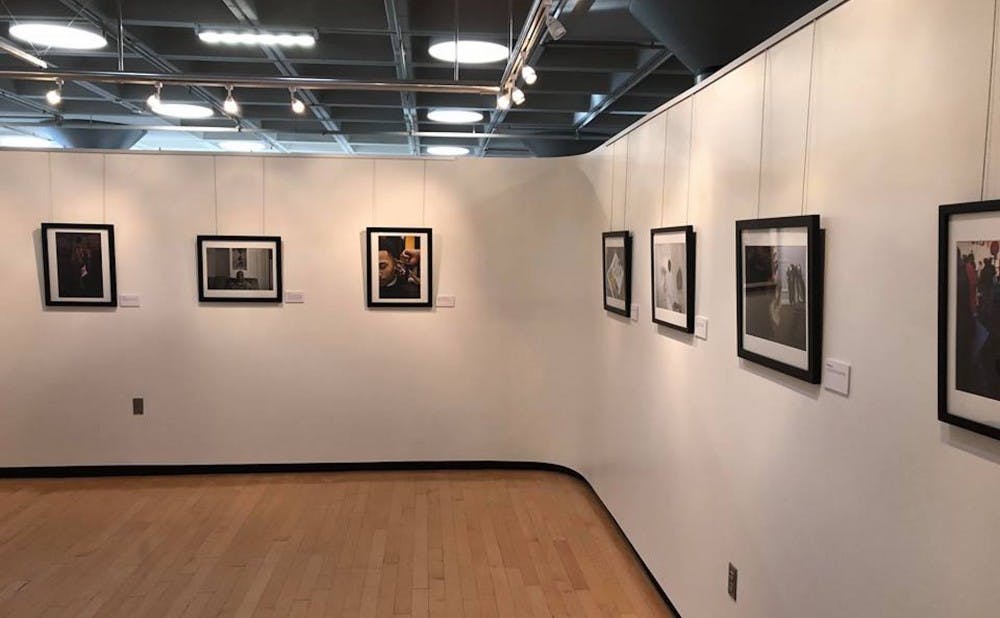On Jan. 15, senior Evan Nicole Bell opened her first solo photography exhibit: “black.” From a conversation with a client at a local barbershop to a usual day in Durham with a friend, stories of black Americans come to life through photographs in her exhibition, which is on display in the Bryan Center’s Louise Jones Brown Gallery.
In the exhibit, Bell juxtaposes photographs of black Americans who she met in person with anecdotes or descriptions about them, which she said make the photos more interesting. The works are from her project in her Program II major, “Documenting Justice: The Role of Photographic Narratives in Activism,” which involves about 10 departments, including Public Policy, Documentary Studies and African American Studies.
Originally interested in artistic photography and social justice volunteer work, Bell said her projects as a documentary photographer have given her chances to combine those two. She began this project in her sophomore year as a part of her color photography class under the guidance of her Program II advisor, Alex Harris. After watching the award-winning 2007 documentary “Welcome to Durham, USA,” which portrayed Durham as a crime-ridden city with predominantly black residents, Bell was eager to produce her own documentary as its antithesis. Filming black artists, doctors and middle and upper class families of the area, she used her camera as a tool to dispel such stereotypes about Durham and its inhabitants.
Receiving the Research in Practice Program Fellowship in the Documentary Arts, Bell continued her project throughout her junior and senior years. But she ended up expanding the range of her subjects to include black Americans of all social classes, not only from Durham but also from her hometown of Columbia, Maryland, to show a broader portrait of what it was like to be black.
Bell recalled that most of her process to document the lives of black Americans included thinking of places that would best represent “blackness” and then reaching out to the associated people to form personal connections with them.
“I would say 80 percent of documentary work takes place when I am not even holding a camera,” Bell said. “So much of it is seeking out sources, building relationships, having conversations and building trust with the people I am photographing.”
Her efforts were rewarded when she was given rare opportunities to closely interact with her subjects. A band director at North Carolina Central University, which has a historically black student body, let her film the marching band on the field. She also got to enter the kitchen at Dame’s Chicken and Waffles, one of the few restaurants in Durham with all black staff members.
But Bell did not intentionally initiate contact with all of her subjects — sometimes, she just happened to run into people who let her photograph them. She once visited a barbershop with her friend to document how black Americans style their “unique” hair. While talking to the barbershop owner, she also got to have a conversation with one of the patrons, who invited her to come to his church to capture its people in her pictures.
This progress that she went through to produce her works enabled her, as a black American and documentary photographer, to see diverse views on what it meant to belong to a racial group that is socially defined in a certain way.
“I am going in [to interact with my subjects], already knowing a lot about black people, because I am black,” Bell said. “But I have so much to learn. [I was] not only telling a story, but also letting the things [I learned] change my own perspective,” Bell said.
Remembering the time when she visited N.C. Central, Bell said that having the opportunity to show her works at the exhibition was also meaningful.
Historically-black colleges like N.C. Central, she said, “were founded because black people were not allowed to go to schools like Duke. ... So to think now that we have made such a progress to the point where I am attending this university, and am able to put on an exhibit that highlights [the strength and beauty of black culture], is important to me.”
Although she began her project a few years ago, before many current political discussions surrounding race, Bell emphasized that she wanted the visitors of her exhibit to derive their own meanings from it.
“It is important to humanize people who are different from you or similar to you,” Bell said. “If you are a viewer walking into my exhibit, whether you are black, white, Asian, or Latino, you are going to leave having learned something.”
“Black.” will be on display from Jan. 15 to Feb. 5. An opening reception for the exhibition is planned on Jan. 24 from 7 p.m. to 9 p.m. at Louise Jones Brown Gallery.
Get The Chronicle straight to your inbox
Signup for our weekly newsletter. Cancel at any time.

